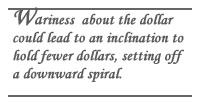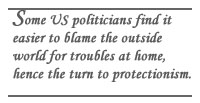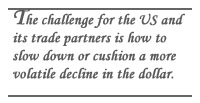Who Gains When the Dollar Sinks?
Who Gains When the Dollar Sinks?

percent less than what it did six years ago (photo by Reuters)
STAMFORD: Since 2001, the value of the US dollar has declined by over 30 percent vis-à-vis other major international currencies. In early November, the US dollar fell to its lowest ever against the euro and the Chinese yuan, and became the cheapest in 26 years against the UK pound. In all likelihood, the value of the US dollar will continue to shrink, posing a challenge for Washington: The US either must get its economic house in order, by reducing debt-financed consumption and rebuilding savings, or learn to live with a decline in American buying power and its influence.
Weakening of American purchasing power does not necessarily mean others will gain, as it could hurt many economies reliant on exports to the US. There’s real danger that wariness about the dollar could lead to an inclination to hold fewer dollars, further eroding value and setting off a protracted downward spiral.

Following the Second World War, the US dollar was the world’s primary currency. Despite periodic ups and downs vis-à-vis other major currencies, the US dollar was regarded as the central currency for international trade and finance. Indeed, it’s still standard for governments to state their level of foreign-exchange reserves in dollars, and all major commodity prices are set in dollars. This dovetails with US policy over the past 13 years supporting a strong dollar. While officials still chant the “strong” dollar mantra, the reality of a shrinking currency casts US options in a different light.
The weakness of the dollar reflects growing problems facing the US economy, one that seeks to pursue both guns and butter. The US maintains a sophisticated and costly military with an extensive global reach. At the same time, government policy focuses on maintaining consumer spending, which accounts for over 70 percent of GDP.
Historically, balancing both economic goals is difficult. The guns part of the equation increasingly weighs on the US economy, considering that the war in Iraq and other missions in Afghanistan and Africa cost between an estimated $3 billion and $6 billion a month. In August, the Congressional Budget Office estimated that as of June 2007 up to $500 billion has been spent on combat operations in Iraq.
The butter side of the economy also has challenges, including a massive buildup in household debt, a lack of prudent fiscal policies in Washington and a housing meltdown. The consumer relied on home equity and low mortgage rates – assured by foreign purchase of US debt – to finance their ongoing shopping binge. The purchase of a cornucopia of goods, many imported, drove America’s household savings into negative territory.

The sustainability of the US guns-and-butter economy also depends on the steady flow of foreign investment into US Treasury, federal agency and corporate bonds. These foreign purchases keep the credit flowing to customers who buy Asian and European goods. Despite worries over the deterioration of savings in the US and the extended period of record current-account deficits, foreign central banks had an interest in upholding this system, even with a gradually declining dollar. In a sense, foreign savers provide American consumers with cheap funds to buy their goods – an ongoing cycle that keeps economic growth in the US and elsewhere moving ahead.
The pinprick to the credit bubble came with the housing-sector meltdown in late 2006. From that point, confidence in the U.S. financial system eroded, especially as the sub-prime toxin seeped into the banks and brokerages as well as those parts of the insurance sector linked to mortgages. With confidence in the financial sector deflated, attention turned to the country’s massive structural problems – a long-term imbalance between government expenditures and revenues, related to ongoing pressure for tax cuts; the rapidly aging national transport and communications infrastructure; and Medicare, Medicaid and Social Security, the combined cost of which is expected to grow 22 percent faster than the economy over the next decade.
Compounding matters, considerable energy is devoted to maintaining an economy of indulgence, with the debt required to keep it going and little thought given to the structural adjustment now in motion. Along these lines, some politicians find it easier to blame the outside world for troubles at home, hence the turn to protectionism, with a number of bills pending in the US Congress.

At the same time, the declining dollar is a growing point of worry for many major international industrial companies, such as Airbus, that either export to the US or price their products in that currency. International businesses are beginning to switch from payments in the US dollar to other currencies, in particular the euro, as the uncertainty surrounding the dollar makes it less attractive. Jim Rogers, a former partner of George Soros, recently announced plans to sell his US home and convert the proceeds into Chinese yuan, adding “I’m moving to Asia because moving to Asia now is like moving to New York in 1907 or London in 1807. It’s the wave of the future.”
As a longer term trend the dollar’s shrinking value bodes ill for the US. This development will reinforce the global economy’s trend towards becoming less US-centric, with economic growth now being picked up by Europe and the BRICs – Brazil, Russia, India and China. According to the International Monetary Fund, developing Asia is expected to grow by 9.8 percent in 2007, compared to 1.9 percent for the US. Even Europe, formerly regarded as a labor-cost/social-spending-top-heavy economic experiment, is expected to grow 2.5 percent, outpacing the US for the first time since 2001.
Investors are more willing to invest in non-dollar currencies for better returns and less currency turmoil. A number of Sovereign Wealth Funds (SWFs), like those from China, Russia and Kuwait, have indicated that their strategies include a de-emphasis of US-dollar assets. The SWFs currently hold around $2.5 trillion; by 2017, that total is expected to expand to $17.5 trillion. It’s also estimated that over the next three years, the SWFs are likely to shift $500 billion out of dollar assets in search of better returns. The trend to invest outside of the US is also evident with American investors, who as of August 2007 had purchased $198 billion in foreign securities, up over 70 percent year-on-year.

While the dollar is likely to remain a safe haven in times of heightened geopolitical stress, the country’s economic troubles threaten to accelerate the currency’s depreciation. The challenge for the US as well as its trade partners is how to slow down or cushion a more rapid and volatile decline in the dollar. A weak dollar not only diminishes the worth of dollar-denominated assets held by foreigners, but also has a chilling impact on Europe, China, India, Japan and the rest of the planet whose wealth is based largely on export to the US market. At the same time, a volatile and diminishing power of US dollar would constrain Washington’s ability to project military power and political influence overseas.
The weaker dollar by itself does not spell the end of US power, but it does signal the shaking of geopolitical plates built on the premise of a strong dollar. If nothing else, it should send a message to Americans that it is time to start putting their economic house in order because the rest of the world is increasingly less inclined to finance its spending.
Scott B. MacDonald is a senior partner and head of research at Aladdin Capital Management, LLC, in Stamford, Connecticut, and currently writing a book on Asia and globalization.